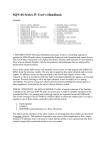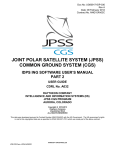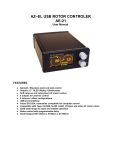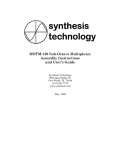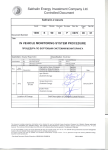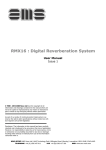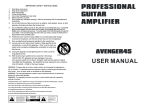Download Review, Modern Recording PDF 368kB
Transcript
Ursa Major Space Station
By John Murphy and Jim Ford
The Space Station SST-282 from Ursa Major is a
highly sophisticated audio signal processing unit
which employs a digital delay line with multiple taps
( outputs) to produce a wide variety of reverb, echo and
comb filter effects. There are sixteen Audition Delay
Programs which provide four basic families of effects:
Rooms, Combs, Delay Clusters and Space Repeats.
There is also a switch for selecting either reverb or
echo mode of operation. The Space Station provides
the user with front panel control over a wide variety of
operating parameters with the result that many
totally unique sound effects can be generated-in addition to the more familiar sounding reverb and echo
effects.
Because of its solid state electronic construction the
unit is insensitive to both high sound pressure levels
and mechanical shock, this combined with the
standard 19-inch rack mount packaging helps make
the Space Station at home both in the studio and on
stage. The Space Station is currently priced at approxi mately $1,995.
General Description:
As is true of most complex
signal processing equipment, it is necessary for the
user to have some understanding of the unit's operation in order to employ it to maximum advantage. So
before going over the front panel controls let's first
consider how the Space Station works.
Ursa Major has provided a block diagram on the
front panel of the Space Station for quick reference
when in use (see photo of front panel). This diagram
80
provides a good starting point for learning about the
station. As you can see, the heart of the processor is a
multi-tap digital delay line. The delay line provides a
maximum of 255 milliseconds (about 1/4 second) of time
delay with a signal bandwidth of 7 kHz. It has one
input and two distinct groups of outputs as well as a
separate echo output.
The first group of delay line taps (shown at the top of
the delay line in the diagram) are summed together
and fed back to the input to generate reverberation
when the unit is used in the reverb mode. Reverb decay
time is determined by the setting of the feedback
control, greater feedback providing longer decay
times. The unit is programmed internally to
"randomize" the placement of the reverberation taps
and avoid the harsh electronic sound of simple fedback delay line reverberators.
The other group of taps (shown at the bottom of the
delay line in the photo) are used to audition the signal
content of the delay line. There are a total of eight
audition delay taps which are mixed in pairs through
MODERN RECORDING
l
The next group of programs is referred to as "Delay
Clusters" and includes five programs. This family
provides eight delays that are closely spaced in time
with the cluster of repeats occurring at progressively
later times going from the programs "Fatty" to
"Echo." In the program labeled "Fatty" the delay of
the echo cluster is less than 40 milliseconds. These
programs provide extra richness for slap echo type
effects.
four front panel level controls along with the direct
signal (on its own level control) to make up the output
signal. Taps 1, 3, 5 and 7 are summed and sent to the
unit's left output while taps 2, 4, 6 and 8 appear at the
right output. The position of the eight audition delay
taps along the delay line determines the time delays
and relative spacing of the initial echoes from the
processor. These eight time delay values are set by
selecting one of sixteen Audition Delay Programs.
There are four groups of programs named "Rooms,"
"Combs," "Delay Clusters" and "Space Repeats."
The first of these, rooms, uses semi-randomly chosen
delays spaced to sound like the early reflections in the
natural reverberant field of real rooms. The longer
time delays are from the later taps so the user can
readily adjust the signal level for the earlier or later
taps to emphasize the earlier or later room reflections
as desired. Rooms 1 through 4 provide increasing
amounts of delay to simulate increasingly larger
rooms.
The four comb programs are intended for special
effects. Closely spaced delays are combined to produce
the series of notches in frequency response commonly
known as a "comb" filter (thus named because the
closely spaced notches resemble the teeth of a comb).
The comb programs provide good sci-fi effects on
voices and can be used to add a tonality to percussive
sounds.
APRIL 1980
"Space Repeats" is the name of the last group of
programs. Three programs provide 2, 3, or 4 echoes
evenly spaced over the 255 milliseconds of available
delay. They provide left/right motion and are especially recommended for use with percussive sounds.
When the "echo" mode of operation is selected the
reverb taps are disconnected from the feedback loop
and the single "echo" tap is connected into the feedback control. The "Echo Delay Time" control is then
used to establish the location of the echo tap anywhere
along the delay line. Long delay times give rise to
decaying repeating echoes, whereas short delay times
produce comb filter effects. These effects can be
further enhanced by auditioning them through more
than one audition delay tap.
Now that we have some idea of how the Space
Station works let's go over the front panel controls
and rear panel connections. At the far left is an input
level control which is used in conjunction with the
LED peak level indicator below. The input signal level
should be set as high as possible without flashing the 0
dB indicator, as signal levels above this will cause
digital overload. To the right of the input level control
are two smaller rotary controls labeled "equalization."
These controls act on all signals entering the delay line
including the feedback signal, providing up to 10 dB of
high or low frequency cut. Since the feedback signal is
affected, these controls have the effect of reducing the
81
decay times of the highs and lows.
The next five rotary controls constitute the output
signal mixer with the first control providing direct
signal at the output. The next four controls allow
mixing of the signals from the eight audition taps.
Each control adjusts the level from a stereo pair of
taps with longer delays on the higher numbered taps.
Continuing across the face of the unit next there is a
pair of push buttons, one for selecting either mixed or
dry output signals, and the other for selecting either
the reverb or echo modes of operation. With the first
control in the "Dry" position the output consists only
of direct signal still under control of the "Direct" level
control. In normal operation this switch would stay in
the "Mixed" position except to bypass the effects. The
reverb/echo feedback control is located at the far right
of the front panel. By varying the level of the reverb or
echo signals fed back to the input of the delay line, the
rate of decay of either type signal can be controlled.
The lower central portion of the front panel is occupied by a set of nine pushbuttons for selecting one of
the sixteen audition delay programs. The first switch
is an alternate action pushbutton which selects alternate groups of programs for the remaining eight (interlocking) pushbuttons. When the first switch is depressed the eight switches select any of the "rooms" or
"combs" programs as indicated by the labels above
the pushbuttons. When the first switch is not
depressed, the "delay clusters" or "space repeats"
programs can be selected as indicated by a second set
of labels below the pushbuttons.
At the right of the program selector switches is
another alternate action pushbutton which when
depressed selects a "long" reverb program as opposed
to a "medium" reverb program when not depressed.
The medium program is said to provide for a normal
build-up and smooth decay of reverberation as
compared to a slower build up and longer decay time
for the long reverb program. Continuing to the right
there is a pair of controls for setting the echo delay
time when the processor is in the echo mode. A rotary
control is labeled 0 to 255 milliseconds and is first set
to the desired echo time. The echo delay time is not
affected until the associated "set" button is pushed, at
which time the echo delay time is updated to the value
selected. Finally, a power on/off pushbutton is located
in the lower right corner of the front panel along with a
pilot LED.
Input/output connections to the Space Station are
by way of 3-pin, XLR-type connectors on the rear
panel. The units accept either a balanced or unbalanced input signal and provides unbalanced stereo
outputs. The pin connections for the input and output
connectors are provided for easy reference on the rear
panel. The only other item at the rear is a connector for
the detachable line cord.
Field Test: The Space Station was field tested at a
82
local 24-track studio where we had the freedom to hear
it on a variety of tracks from multi-track master tapes.
The Station was interfaced through the console patch
bay so that its reverb quality could be readily
compared with that of several other reverberation
systems on hand. We compared the quality of the
various reverb systems on a variety of program
material including solo vocal tracks, solo acoustic
piano, and solo drum tracks.
We heard some pretty good reverb from the Space
Station, but it was not quite as "natural" sounding as
either of the two spring reverbs (studio quality types)
or the standard plate reverb with which it was
compared. However, the Space Station provided
reverberation clearly superior to that of another
digital reverb unit to which we compared it. In
contrast, the Station seemed more diffuse and less
colored than the other digital unit. Reverb was most
natural with the moderately long decay times that
result from moderate amounts of feedback. Higher
feedback levels seemed to result in an electronic
sounding "hash" towards the end of the decay. We
don't feel that this would be a serious problem in most
applications however, as the low level hash would
typically be masked by program material.
As a special effects unit (as opposed to a
reverberation unit) the Space Station truly excels. We
found the effect of the delay cluster programs
especially appealing on percussive sounds ("fatty"
handclaps were great!) while the space repeats
programs gave an interesting "machine gun" effect on
snare pops. The operator's manual provides over
twenty "recipes" of control settings for various
effects, most of which we auditioned. Needless to say,
most of these have to be heard to be appreciated but
they included such effects as: doubling, comb filtering,
thickening, slap, ricochet reflections, resonance,
fattened echo and pure delay. All in all we heard quite
a wide variety of effects and especially combinations of
effects (reverb through a comb filter for example). The
unit's noise was not noticeable and there was no subjective impression of limited high frequency bandwidth.
We performed our usual listening test back at the
shop by connecting the Space Station into a tape
monitor loop of the preamp in our reference system.
Listening to high quality discs through the direct
signal path of the processor we noticed only a slight
"softening" in the high frequency range when the unit
was switched into the listening chain.
Lab Test:
For specific results of the lab test see the
accompanying Lab Test Summary. The input of the
Space Station was found to be relatively insensitive
with no less than a -0.6 dBV input signal level
required for a 0 dB peak level indication. Thus, an
auxiliary line amp may be required for interfacing with
systems standardized on -10 dBV signal levels. Inter-
MODERN RECORDING
We noted that the unit is excellently constructed
using modular printed circuit cards with all the integrated circuits (and there are lots of them!) in sockets
for easy maintenance. The user's manual for the Space
Station provided sufficient discussion of the processor's operation to allow a new user to obtain good
results.
Conclusion:
Fig. 1: Ursa Major Space Station: Frequency
response of dry and delayed signal paths.
facing with +4 dBV systems should present no
problem.
Noise performance through the dry signal path was
not quite as good as some professional audio equipment we've encountered and the noise level for the left
output was about 6 dB higher than for the right
channel. The noise level increased when the four audition taps were set at maximum level but was still a
respectable -66.8 dBV. THD through the direct
signal path was quite low (about .003%) increasing
about tenfold at 10 kHz (to about .03%). For 0 dB level
signals through the delay line THD was about 0.12%.
Bandwidth through the dry path was 6 Hz to 20
kHz. The high frequency bandwidth through the delay
path was limited to 7 kHz by a very steep anti-aliasing
filter (see Figure 1). Although more extended high
frequency bandwidth would be desirable we observed
that the highest octave wasn't really missed in the
reverb and effects (maybe because of the full
bandwidth of the direct signal).
In testing the direct signal path of the unit we
observed that the unit could be driven into slew limiting by high level, high frequency tones. The observed
slew rate limit was 0.4 volts per microsecond which
implies a slew rate ratio (slew rate limit divided by
peak output voltage swing) of 0.054 volts per microsecond per peak volt out. When compared to the recommended minimum slew rate ratio for freedom from
slewing induced distortion (0.5) 1 it appears that slewing headroom is marginal. A quick calculation reveals
that the slew rate ratio will be maintained above 0.5
for input signal levels up to - 19.3 dB peak level. However, operating the unit with such a low input signal
level would degrade its noise performance. The best
compromise might be to operate the unit with somewhat reduced input levels, say by allowing the - 6 dB
LED to only rarely flash.
J.G. Jung; M.L. Stephens; C.C. Todd, "An Overview of SID and
TIM, Part II." Audio, July, 1979
1
84
The Ursa Major Space Station is an
audio signal processing unit which employs a multi-tap
digital delay line to generate a wide variety of special
effects as well as high-quality reverberation. The
Space Station maintains a good level of audio quality.
But a sound effects unit like this has to be heard to be
appreciated. So if you're looking for a time delay
effects unit we suggest you make sure to audition the
Space Station.
LAB TEST SUMMARY
( Note: 0 dBV is referenced to.775 Vrms)
I nput/Output Levels
Minimum input level for 0 dB peak level
i ndication:
- 0.6 dBV
+ 7.0 dBV
Output level for 0 dB indication:
(dry signal only with the ''direct" level
control at maximum)
Output clips at:
+ 16.6 dBV
Noise Performance
(20 kHz filter, unweighted)
For a dry signal only, noise
- 74.2 dBV (R)
of the output is:
- 67.9 dBV (L)
With the four audition taps at maximum,
noise at the output is:
- 66.8 dBV
Distortion Performance
(THD plus noise at 0 dB peak level indication
Frequency
Dry Output
Delayed Output
1 kHz
. 0036%
. 12%
1 0 kHz
. 037%
1 00 kHz
. 0032%
Dry signal path:
. 12%
Bandwidth
( - 3 dB points)
Delayed signal path:
Slew rate limit:
(dry signal path)
-
6 Hz to 20 kHz
1 0 Hz to 7.1 kHz
Slewing Performance
0.4 volts per microsecond
Slew rate ratio
( at 0 dB peak level, dry signal path)
0.054 volts per microsecond per peak volt
CIRCLE 30 ON READER SERVICE CARD
9
MODERN RECORDING




